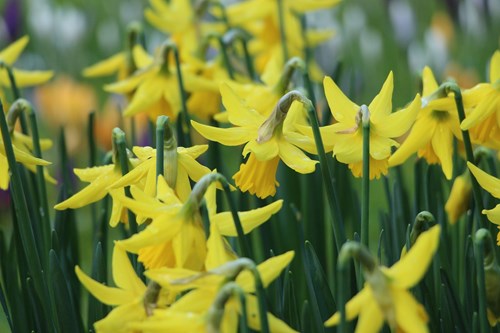Happy St Davids Day
Happy St Davids Day
March 1st is Saint Davids day(Welsh: Dydd Gwyl Dewi Sant) and is the feast day of Saint David, the patron saint of Wales. The date of March 1st was chosen in remembrance of the death of Saint David on that day in 589, and has been celebrated by followers since then. The date was declared a national day of celebration within Wales in the 18th century.

To celebrate this day, people wear a symbol of either a leek, or daffodil. The leek is patriotic, arising from an occasion when a troop of Welsh were able to distinguish each other from a troop of English enemy dressed in similar fashion by wearing leeks. An alternative emblem developed in recent years is the daffodil, used and preferred over the leek by the British Government as it lacks the overtones of patriotic defiance associated with the leek
Dewi Sant - St. David was born towards the end of the fifth century, less than a hundred years after the last Roman legions had marched out of Wales. He was a scion of the royal house of Ceredigion, his mother was Non, daughter of Cynyr of Caio, remembered by numerous churches and holy wells in Wales, Cornwall and Brittany. Educated at Henfynyw (Old Menevia) in Ceredigion, where he 'learned the alphabet, the psalms, the lessons for the whole year, the Masses and the Synaxis', he founded a Celtic monastic community at Glyn Rhosin (The Vale of Roses) on the western headland of Sir Benfro, at the spot where St. David's Cathedral stands today. The spot may well have been the site of a very early religious community, for it is also associated with St. Patrick, the patron saint of Ireland, who may have been born in Wales and is said to have spent time at Glyn Rhosyn before embarking again (this time voluntarily) for Ireland from Porth Mawr nearby.
David's fame as a teacher and ascetic spread throughout the Celtic world. He earned the curious nickname Dewi Ddyfrwr - David the Waterman - no doubt reflecting the harsh bread-and-water regime of Celtic monks. Many traditions and legends are associated with him. When he rose to address to a great crowd at a synod at Llanddewi Brefi in Ceredigion, the ground rose under his feet forming a little hill so that all could hear him speak. Again, a golden-beaked dove is said to have landed on his shoulder as a symbol of his holiness.
His foundation at Glyn Rhosin became one of the most important shrines of the Christian world, and the most important centre in Wales. Roads and tracks from all over the nation led to it and in the Middle Ages two pilgrimages to Menevia was equal to one to Rome (Dos i Rufain unwaith, ac i Fynyw ddwywaith - Go to Rome once, and come to Monmouth twice). Over fifty churches and innumerable holy wells were dedicated to him in Wales alone.
The religious centre of St David's thus became a focus for the religious aspirations of the Welsh nation and as Gerallt Cymro (Giraldus Cambrensis) relates: The Bishopric of St Davids became ... a symbol of the independence of Wales ... and that is why David himself was exalted into a Patron Saint of Wales.
The date of Dewi Sant's death is recorded as March 1st, but the year is uncertain - possibly 588. As his tearful monks prepared for his death St David uttered these words: 'Brothers be ye constant. The yoke which with single mind ye have taken, bear ye to the end; and whatsoever ye have seen with me and heard, keep and fulfil' and as he died 'Lords, brothers and sisters, be cheerful, keep the faith, and do those little things which ye have seen me do and heard me say.'
Public celebrations of St. David's Day are becoming more commonplace. In many towns an annual parade through the centre of town is now held (see above). Concerts are held in pubs, clubs, and other venues.
Many Welsh people wear one or both of the national emblems of Wales on their lapel to celebrate St. David: the daffodil (a generic Welsh symbol which is in season during March) or the leek (Saint David's personal symbol) on this day. The association between leeks and daffodils is strengthened by the fact that they have similar names in Welsh, Cennin (leek) and Cenhinen Pedr (daffodil, literally "St Peter's leek").

